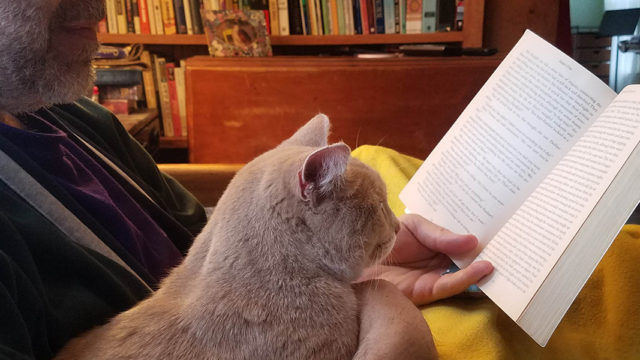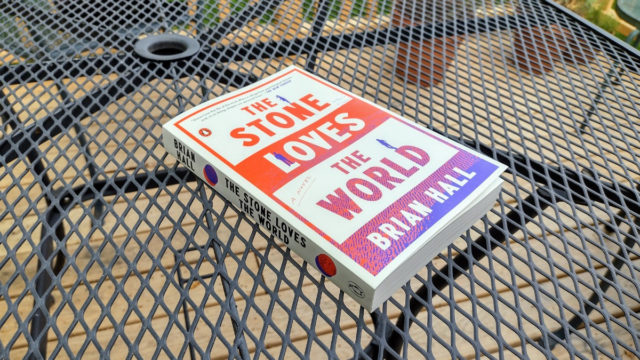I’ve wanted for a while to have a place on my website where I could post random thoughts, but I’ve never gotten around to it because I overthink everything, especially my writing. My most recent novel, The Stone Loves the World, is partly based on my childhood and my family, and while writing it I went through every box in my deceased parents’ capacious attic and basement. I discovered a lot of things, and remembered a lot of other things, and some of it went into the novel and a lot of it didn’t. I’m sixty-one years old, and it’s gradually becoming clear to me that if there are things I want to do before I die, maybe I should start doing them now. Learning Korean is one (my wife is Korean-American), and posting aimless musings about my writing, my reading, my parents, and my childhood is another. Since I overthink everything, especially my writing, my wistful goal is to be relaxed and chatty with these postings. Hence the name.
Chatter
This man and music
When I was young, my father dutifully paid the family bills in a small enclosed porch opening off the bedroom he shared with my mother in our house in Lexington, Massachusetts. There was just enough room for a secretary, a chair, a narrow bookcase, and two filing cabinets. On the shelves behind the glass doors of the secretary he kept memorabilia: a 1961 Ford Thunderbird he’d made from a plastic model kit and painted cherry-red when my brother and I were toddlers (anticipating, he once told me, the father-son model making to come); a home run baseball he’d got his hands on from inside the scrum when it rolled under the bleacher seats in an Orioles game in the 1950s; a kaleidoscope; a prism; a beautiful old ivory Keuffel & Esser sliderule from his graduate school days; The Bluejacket’s Manual. On the outside of one of the doors, tucked between the glass and a fake mullion, was a photograph taken of him while he was in the U.S. Navy:
I regret the damage, which is all my fault. I’ve loved that photograph ever since I was a small child, and after my father died and I inherited his secretary, I made sure to slip the picture into its old place, by way of a memorial. But I neglected to consider that the room in which I keep the secretary, unlike my father’s old cubby-hole, gets a lot of direct sunlight.
Stone, paper, scissors
Today, June 14, is the official publication date for the paperback edition of The Stone Loves the World. Hooray! The design of the hardcover edition has been my favorite of all my books—many thanks to Colin Webber and the Viking art department—and the paperback is even better, although I doubt anyone but the greedy-eyed author would ever notice the difference. (So I’ll just tell you: the eclipsing celestial bodies on the spine, formerly bald, have been given a texture echoing the sand-beach pattern on the front. Brilliant!)
There is one other change, which is internal. When I was writing this novel, I wanted to be as meticulous about factual details as the main character, Mark, prides himself on being. For example, a number of the chapters occur on specific dates, and I made sure that any mention of the weather, the phase of the moon, or the time of sunrise or sunset would be correct for those dates. The Greyhound bus that Mette takes from New York City to Seattle precisely follows the real Greyhound schedule. When Mark looks up NASA’s Astronomy Picture of the Day on February 18, 2016, the image he sees is the one that was really posted on that date. Etcetera.
You might think, then, that I would have avoided making any truly egregious chronological errors. But you’d be wrong. On p. 211 of the hardcover edition, Vernon refers to the cartoonist Walt Kelly’s famous quip, “We have met the enemy and he is us.” Unfortunately, Vernon is speaking in 1958, whereas Kelly didn’t make the joke until 1970. (My thanks to reader Tony for pointing this out to me, with exquisite tact.) In the paperback edition, that sorry-ass error has been quietly cut out.
Everything else is the same. But if you want the 100% guaranteed correct text with the nicely textured celestial bodies on the spine, even if you already own the hardcover, you’ll just have to shell out for the paperback. Act now, before Tony gets in touch with me again.
Pegasus
My mother never liked television, preferring to read mystery novels in her spare time. When, at the age of 77, she began to suffer dementia, she kept track of a book’s characters by writing their names on sticky tabs and affixing them to the pages on which they appeared. Her paperbacks bristled with scores of these brave little yellow flags. Then she surrendered, and started watching TV.
When I drove to Massachusetts on weekends to pay her bills, scout out needed repairs, and consult with her day-time aides, I would spend part of every day sitting on the couch with her in front of the tube. She still couldn’t stand broadcast or cable, she wanted to see only a handful of movies and series that she owned on DVD: Miracle of the White Stallions, National Velvet, a boxed set of three TV movies based on Dick Francis mysteries, The New Adventures of Black Beauty, The Saddle Club, and several equestrian documentaries. I saw all of these movies, episodes, and specials many times. Now and then, hoping for a little variety, I would suggest Babe, which I had bought for her, but she rarely agreed—the part of the horse in that movie was too small.
Enough
While writing the previous post, 1976, I was aware that the clueless male sexism I was describing continued for many years afterward, and indeed, is still alive and kicking today—though much of it has grown less clueless and more malicious. I referred to Robert A. Heinlein’s novel, Time Enough for Love, published in 1973. Many of Heinlein’s later works feature guru-like old men mounting very young and very grateful women, and honestly, I can’t remember if my queasy memories of these variations on a theme are principally from Time Enough for Love or from his 1970 novel, I Will Fear No Evil. I gave up reading Heinlein after those two weighty products of one-handed typing, and I can’t bear the thought of slogging through either of them now in order to check.
1976
On September 3, 1976—the day Viking 2 touched down successfully on the surface of Mars—I bellied up to a registration table in a hotel in Kansas City, Missouri, to receive my name tag and program book for MidAmeriCon, the 34th World Science Fiction Convention. I was seventeen years old. Other than Jennifer Vozoff, with whom I had held hands on the school bus three days running when I was in third grade, I had not yet had a girlfriend.
I was a devoted reader of science fiction, but I had never been to a science fiction convention. Standing outside the Imperial Ballroom, waiting to get into the Opening Ceremonies, I looked around at the attendees, mostly male, and thought, What a bunch of unattractive geeks and social outcasts. (I would discover later that many male science fiction fans think this when first encountering other male science fiction fans.) The fellow I mainly recall had the signature unwashed, scraggly hair and was playing parodic tunes of his own invention on a portable keyboard powered by his breath. Whenever he removed the flexible hose from his mouth, a quarter cup of saliva would dribble over the mouthpiece. He called himself Filthy Pierre.
Margot Livesey and I at Porter Square Books November 8
I’m delighted to be getting together with an old friend, the wonderful novelist Margot Livesey, for a conversation about The Stone Loves the World at 7pm EST this coming Monday, November 8. Margot and I will be sitting together in the actual bookstore in Cambridge MA, but the event will be disseminated via Crowdcast. Here’s the link. I’ll also read a little from the novel, but our talk will predominate because, come on, doesn’t everyone prefer conversation to readings? There will also be a Q&A, so please register, say hello, and feel free to ask me some “gotcha” questions.
My dad and the Nobel Prize
In my novel The Stone Loves the World, the character Vernon is based on my father, with some differences. For example, whereas Vernon worked at RAND from 1956-58, my father spent those years teaching undergraduate physics at his alma mater, Wake Forest College. Unlike Vernon, my father never worked in nuclear physics or nuclear bomb design. Like Vernon, he spent the bulk of his career analyzing the interaction of ultraviolet light with the Earth’s upper atmosphere. He published papers with titles such as, “Solar Extreme Ultraviolet Photon Flux Measurements in the Upper Atmosphere of August 1961,” and “Diurnal Variation of the Atmosphere around 190 Kilometers Derived from Solar Extreme Ultraviolet Absorption Measurements,” and “Solar Ultraviolet Irradiance at 40 Kilometers in the Stratosphere.” He was known for his talent for building the spectrometers to be used in his flights, and for his extreme meticulousness in calibrating them in the lab beforehand.






